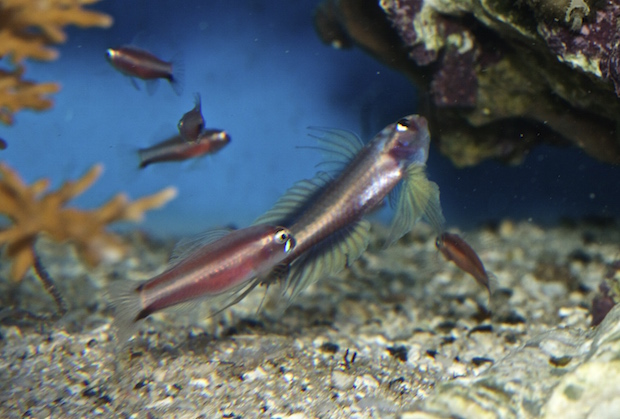These particular few weeks have played host to a flurry of aquaculture stories, from Bali Aquarich’s hybrid Pomacanthus and brand new A. trimaculatus, to Biota Marine’s captive bred Clown Triggerfish. Palau based Tom Bowling and Till Deuss from Biota Marine are back again with more news on cultured fish, but this time with a stark contrast in terms of species when compared to their previous acclaims. Tom and company adds four species of Eviota to their growing list of cultured species, which includes amongst others, their iconic thread-fin snappers, bumphead parrotfish and clown triggers.

Eviota, like Trimma, are small colourful fish that are popular and evergreen with nano enthusiasts. Available in literally an endless stream of design permutations, these little fishes are some of the most diverse, with a large majority of new scientific contributions being attributed to these two genera alone. With their playful and demure nature, it’s little wonder why these nano gobies make popular aquarium pets. Biota Marine has successfully cultured four species in the genus Eviota, and they are E. bifasciata, E. nigriventris, E. atriventris and E. punctulata; all of which are firsts for their species.
Eviota bifasciata
In this beautiful species, the body is deep russet transversed by a pale bone coloured horizontal belt. An additional stripe in a slightly paler shade runs parallel along the dorsum, and the belly is pale. The face is only sporadically decorated with cyan spotting, making this fish a very attractive species when kept in a group. E. bifasciata is a schooling species, and is often found in large groups hovering over tabling Acropora in shallow water. Males are particularly impressive during courtship display, and impress females by changing coloration as well as spreading their fins, as seen in the headlining photo above.
E. bifasciata spawns in nests where several females may be courted by the same male. In the aquarium, this species can be kept successfully in a group, preferably with tabling SPS and other suitable coral heads where they can display their natural behavior.
Eviota nigriventris

Eviota nigriventris shares the same general colour scheme as the preceding species, but lacks the horizontal middle stripe. Instead, the stripe runs along the dorsum and occupies a significantly large portion of the body area, sometimes encroaching to the lateral line. The specific epithet nigriventris means “black-belly”, but the species more often than not adopts a clear coloured belly instead. E. nigriventris is closely associated with live corals as well, especially Acropora and Seriatopora.
Till Deuss reports of a captive pair living for more than four years, which is a remarkably long time frame for an Eviota and other similarly sized dwarf gobies.
Eviota atriventris

Eviota atriventris is curious in sharing the same etymology as the previous species, with the epithet atriventris being a synonym for “black-belly”. In this species, the black belly is more prominent and is a standout feature which often leads to confusion with Eviota pellucida, another common and superficially similar species. This beautiful fish is tangerine over much of its body, with various degrees of translucency especially along its dorsum and posterior half. The head is adorned with a series of electric yellow stripes which passes through the eye and stops mid length, where it encircles the top portion of its namesake black belly. A single blue stripe shot in silver runs horizontally across the belly.
This goby is found in a slightly different habitat, preferring to live solitarily or in small groups between coral heads, often in shaded areas. Unlike the previous two species, it prefers perching on substrate rather than actively hovering, although it does do so from time to time. This is perhaps one of the more popular Eviota available to the market.
Eviota punctulata

The last of the four captive raised Eviota is E. punctulata. This curious little species is not as colourful as the preceding three, and has an overall different form and colouration. E. punctulata is green with a series of mahogany spots and blotches that run in a roughly horizontal fashion along the lateral line. The face is decorated with a series of speckles in the same colour, and the belly region is strongly marked with a series of vertical striations. This species is very much more demersal than the others, preferring to skip along the substrate instead of hovering.
E. punctulata is found singly amongst dead coral and rubble in the reef, where its cryptic coloration helps it to blend with its surroundings more effectively.
Biota reports that all four species share roughly the same early developmental requirements. The larvae of E. bifasciata, E. nigriventris, E. atriventris and E. punctulata are roughly 2mm post hatching, and are fed SS rotifers and calanoid copepods (Parvocalanus crassirostris) up till the eighteenth day, where they are weaned onto Artemia nauplii. The larval duration of all four species clocked in at about a month, with E. nigriventris settling the earliest at twenty three days, followed by E. punctulata at twenty six, and the other two species a few days later.

Once settled, the juvenile fish and adults are then fed small pellets. Biota Marine is happy to offer these captive bred Eviota to the market where they are currently ready and available to be shipped out. A big thanks to Tom Bowling and Till Deuss for the photos and information, and a huge congratulations for pushing the envelope on the aquaculture front. Who would have guessed that 2015 would be the year of captive raised fish. It’s almost mid April, and there’s no sign of it slowing down.



